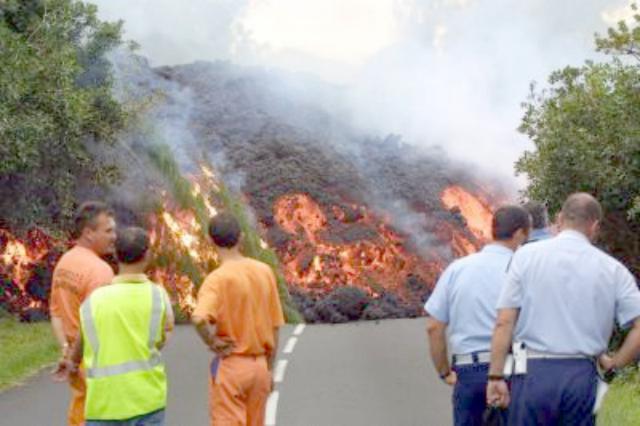Report on Piton de la Fournaise (France) — July 2001
Bulletin of the Global Volcanism Network, vol. 26, no. 7 (July 2001)
Managing Editor: Richard Wunderman.
Piton de la Fournaise (France) 11 June-7 July eruption; two lava flows block highway
Please cite this report as:
Global Volcanism Program, 2001. Report on Piton de la Fournaise (France) (Wunderman, R., ed.). Bulletin of the Global Volcanism Network, 26:7. Smithsonian Institution. https://doi.org/10.5479/si.GVP.BGVN200107-233020
Piton de la Fournaise
France
21.244°S, 55.708°E; summit elev. 2632 m
All times are local (unless otherwise noted)
A short seismic crisis with 126 recorded events started at Piton de la Fournaise on 11 June 2001 at 1327. At 1350 extensometer variations indicated that a new eruption had started on the ESE flank, in the same area as the previous eruption on 27 March 2001. En echelon fissures started at about 2.5 km elevation on the S flank, 200 m below the Dolomieu summit caldera. More fissures were located between 1.8 and 2 km elevation on the E flank at the southern base of crater Signal de l'Enclos and N of the Ducrot crater. Several lava flows descended the Grand Brûlé but their progression was very slow; at 1700 the front of the lava flow was still located at an elevation of ~1.5 km. On the morning of 12 June, only the lower fissure at 1.8 km elevation was still active. It was ~200 m long, with several lava fountains 20-30 m high. The lava flow followed the northern border of the 27 March lava and descended to about 400 m elevation in the Grand Brûlé.
On 16 June a cone began to form and lava fountains rose up to 30 m above the surface in an area at 1.8 km elevation. An active fissure was located on the E flank at the S base of crater Signal de l'Enclos. Tremor weakened but continued under the volcano's E flank through late June. Lava fountains were visible at two vents; at one vent strong degassing occurred, while at the other vent a boiling lava lake occasionally overflowed, sending lava towards the NE. New lava flows were observed on 29 June in the Grand Brûlé area traveling to the N. On 1 July an increase in tremor occurred for about 1 hour and was accompanied by strong degassing at the cone and a strong amount of lava emission. Several dozen small flows were visible by the next day. Tremor and the intensity of local earthquakes increased during the first week of July. The earthquakes had magnitudes less than 3 and were located under Dolomieu crater at a depth near sea level. On 6 and 7 July two aa lava flows, 80 and 100 m wide and up to 5 m high, crossed the national highway in the Grand Brûlé area (see figure 65). On the afternoon of 7 July the end of the eruption was marked by the disappearance of tremor and a dramatic decrease in the intensity of local earthquakes.
 |
Figure 65. On 6 July 2001, police and security personnel watch as molten lava from Piton de la Fournaise blocks the main national RN 2 road, which connects Réunion island from E to S. |
Geological Summary. Piton de la Fournaise is a massive basaltic shield volcano on the French island of Réunion in the western Indian Ocean. Much of its more than 530,000-year history overlapped with eruptions of the deeply dissected Piton des Neiges shield volcano to the NW. Three scarps formed at about 250,000, 65,000, and less than 5,000 years ago by progressive eastward slumping, leaving caldera-sized embayments open to the E and SE. Numerous pyroclastic cones are present on the floor of the scarps and their outer flanks. Most recorded eruptions have originated from the summit and flanks of Dolomieu, a 400-m-high lava shield that has grown within the youngest scarp, which is about 9 km wide and about 13 km from the western wall to the ocean on the E side. More than 150 eruptions, most of which have produced fluid basaltic lava flows, have occurred since the 17th century. Only six eruptions, in 1708, 1774, 1776, 1800, 1977, and 1986, have originated from fissures outside the scarps.
Information Contacts: Thomas Staudacher and Georges Boudon, Observatoire du Piton de la Fournaise Institut de Physique du Globe de Paris - B89, 4 Place Jussieu, 75252 Paris cedex 05, France.

